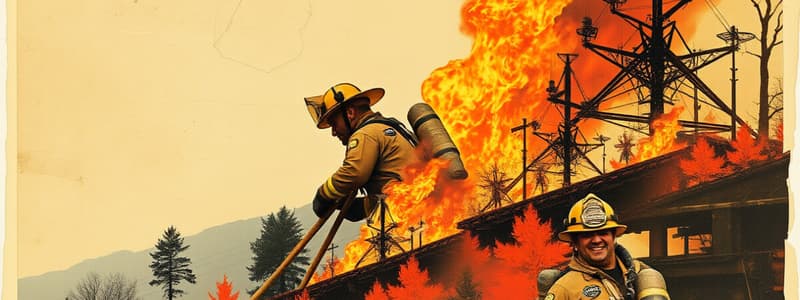Podcast
Questions and Answers
What is considered the primary goal when immediate control of a brush fire is not possible?
What is considered the primary goal when immediate control of a brush fire is not possible?
- Creating fire breaks
- Evacuating nearby residents
- Protecting exposures (correct)
- Extinguishing the fire completely
Which of the following is NOT a component of the initial size-up process for fire incidents?
Which of the following is NOT a component of the initial size-up process for fire incidents?
- Anticipated resource needs
- Public relations strategy (correct)
- Identifying hazards
- Rate of fire spread
What factor regarding the fuel is critical to assess during a fire incident?
What factor regarding the fuel is critical to assess during a fire incident?
- Color of the fuel material
- Age of the vegetation
- Type of vegetation in the area (correct)
- Distance from water sources
In what way does wind speed impact fire behavior during a brush fire?
In what way does wind speed impact fire behavior during a brush fire?
Which topographical feature can influence the tactics applied to a brush fire?
Which topographical feature can influence the tactics applied to a brush fire?
What is the significance of assessing flame length during the size-up process?
What is the significance of assessing flame length during the size-up process?
Which aspect of topography can greatly influence the tactics employed during a fire response?
Which aspect of topography can greatly influence the tactics employed during a fire response?
How does weather relative humidity impact the strategy for managing a brush fire?
How does weather relative humidity impact the strategy for managing a brush fire?
In the context of fire incidents, what is the primary purpose of conducting a thorough size-up?
In the context of fire incidents, what is the primary purpose of conducting a thorough size-up?
Which factor regarding resource assessment is crucial when responding to a brush fire?
Which factor regarding resource assessment is crucial when responding to a brush fire?
Flashcards are hidden until you start studying
Study Notes
Firefighting Tactics and Strategy
- Brush fires can rapidly spread across large areas, making the selection of an attack point crucial.
- Primary goal during uncontrolled fire is the protection of exposures, including structures and utilities.
Size-Up
- Conducting a detailed size-up is essential for significant fire incidents to formulate an effective firefighting plan.
- The incident commander should invest time in gathering vital data regarding:
- Fire Location: Identifying heads and spread patterns.
- Fire Size: Understanding its scale and speed of advancement.
- Flame Length: Observing the height of flames for tactics assessment.
- Spot Fires: Monitoring smaller ignitions that can complicate efforts.
- Accessibility: Evaluating routes into the fire area for units and resources.
Fuel Considerations
- Assess fuel continuity to determine how readily fire can spread.
- Recognize the type of fuel present—grass, brush, or trees—and factor in its impact on fire behavior.
- Evaluate fuel loading as light or heavy, influencing the fire's intensity and spread potential.
Weather Factors
- Monitor temperature, wind speed, and direction as they significantly affect the fire's behavior.
- Consider relative humidity levels that can impact fuel dryness and combustion.
Topography
- Determine the terrain: flat ground presents different challenges than hilly landscapes.
- Identify fire position: assess if the fire is at the bottom, middle, or top of a hill to strategize attack angles.
Hazards
- Identify exposures such as buildings, crops, and other improvements that may be endangered.
- Account for special hazards like hazardous materials or potential spot fires that may arise unexpectedly.
Resources
- Assess manpower requirements necessary for effective control.
- Identify available water resources, such as fire tenders and hydrants, which are crucial for suppression efforts.
Incident Action Plan
- Based on the size-up, command must quickly formulate an incident action plan to guide firefighting efforts effectively.
Firefighting Tactics and Strategy
- Brush fires can rapidly spread across large areas, making the selection of an attack point crucial.
- Primary goal during uncontrolled fire is the protection of exposures, including structures and utilities.
Size-Up
- Conducting a detailed size-up is essential for significant fire incidents to formulate an effective firefighting plan.
- The incident commander should invest time in gathering vital data regarding:
- Fire Location: Identifying heads and spread patterns.
- Fire Size: Understanding its scale and speed of advancement.
- Flame Length: Observing the height of flames for tactics assessment.
- Spot Fires: Monitoring smaller ignitions that can complicate efforts.
- Accessibility: Evaluating routes into the fire area for units and resources.
Fuel Considerations
- Assess fuel continuity to determine how readily fire can spread.
- Recognize the type of fuel present—grass, brush, or trees—and factor in its impact on fire behavior.
- Evaluate fuel loading as light or heavy, influencing the fire's intensity and spread potential.
Weather Factors
- Monitor temperature, wind speed, and direction as they significantly affect the fire's behavior.
- Consider relative humidity levels that can impact fuel dryness and combustion.
Topography
- Determine the terrain: flat ground presents different challenges than hilly landscapes.
- Identify fire position: assess if the fire is at the bottom, middle, or top of a hill to strategize attack angles.
Hazards
- Identify exposures such as buildings, crops, and other improvements that may be endangered.
- Account for special hazards like hazardous materials or potential spot fires that may arise unexpectedly.
Resources
- Assess manpower requirements necessary for effective control.
- Identify available water resources, such as fire tenders and hydrants, which are crucial for suppression efforts.
Incident Action Plan
- Based on the size-up, command must quickly formulate an incident action plan to guide firefighting efforts effectively.
Studying That Suits You
Use AI to generate personalized quizzes and flashcards to suit your learning preferences.




